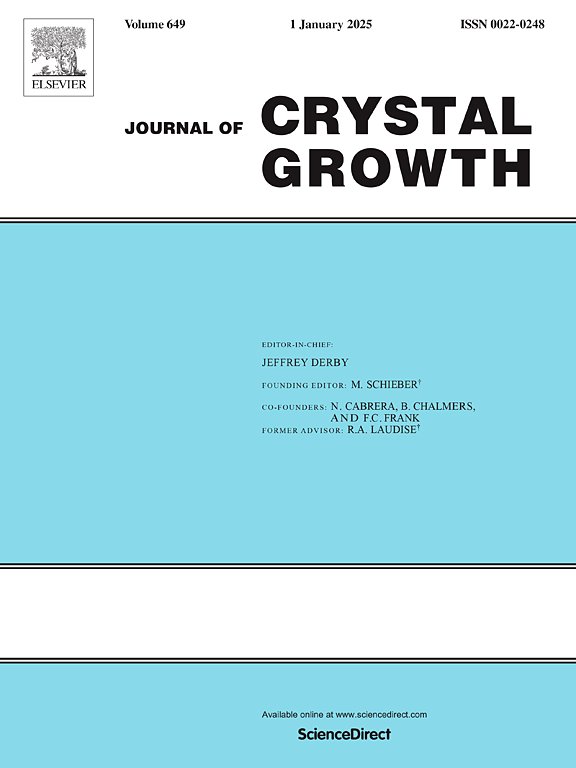Relationship between temperature gradient and growth rate during CZ silicon crystal growth
IF 1.7
4区 材料科学
Q3 CRYSTALLOGRAPHY
引用次数: 0
Abstract
Temperature distribution in the growing crystal is the most important parameter that determines the grown-in-defects, growth rate, etc. There is a discussion either higher growth rate leads to larger thermal gradient or smaller thermal gradient. In this study, in order to make clear the reason of this discrepancy, the effects of growth rate on the shape of melt/crystal interface, and temperature distribution in growing crystal were investigated by numerical modeling. Firstly, as increasing the growth rate, the shape of melt/crystal interface becomes more concave. And temperature gradient along center axis on growing crystal increases as increasing the growth rate. On the other hand, temperature gradient along surface of growing crystal decreases as increasing the growth rate. To obtain higher growth rate, heat transfer should be enhanced. Along the center axis, heat transfer in vertical direction by heat conduction is dominant. Then concave interface shape and larger thermal gradient along center axis were obtained. In the periphery of grown crystal near the triple points, because of concave interface shape, heat transfer in radial direction, and radiative heat transfer from growing crystal become more important than heat transfer in vertical direction. Then smaller thermal gradient along the growing crystal surface was obtained. This surface temperature profile agrees well with Abe’s measurement results. It is cleared that higher growth rate leads to the higher heat transfer, and melt/crystal interface shape, and temperature distribution in growing crystal are determined by the balance of growth rate and heat transfer between heat conduction in vertical direction and heat conduction in radial direction combined with radiation heat transfer from crystal surface.
CZ 硅晶体生长过程中的温度梯度与生长速度之间的关系
生长晶体中的温度分布是决定生长缺陷、生长速度等的最重要参数。对于生长速率越高导致热梯度越大还是越小导致热梯度越大,一直存在争议。在本研究中,为了明确造成这种差异的原因,我们通过数值建模研究了生长速率对熔体/晶体界面形状以及生长晶体中温度分布的影响。首先,随着生长速率的增加,熔体/晶体界面的形状变得更加凹陷。随着生长速率的增加,生长晶体上沿中心轴的温度梯度也随之增加。另一方面,沿生长晶体表面的温度梯度随着生长率的增加而减小。要获得更高的生长率,就必须加强传热。沿着中心轴,热传导在垂直方向上的传热占主导地位。因此,沿中心轴的界面呈凹形,热梯度较大。在生长晶体外围靠近三重点的地方,由于界面呈凹形,径向传热和生长晶体的辐射传热比垂直方向传热更重要。因此,沿生长晶体表面的热梯度较小。这一表面温度曲线与 Abe 的测量结果非常吻合。由此可见,生长速率越高,热量传递越多,熔体/晶体的界面形状以及生长晶体的温度分布取决于生长速率和热量传递之间的平衡,即垂直方向的热传导、径向方向的热传导以及晶体表面的辐射传热。
本文章由计算机程序翻译,如有差异,请以英文原文为准。
求助全文
约1分钟内获得全文
求助全文
来源期刊

Journal of Crystal Growth
化学-晶体学
CiteScore
3.60
自引率
11.10%
发文量
373
审稿时长
65 days
期刊介绍:
The journal offers a common reference and publication source for workers engaged in research on the experimental and theoretical aspects of crystal growth and its applications, e.g. in devices. Experimental and theoretical contributions are published in the following fields: theory of nucleation and growth, molecular kinetics and transport phenomena, crystallization in viscous media such as polymers and glasses; crystal growth of metals, minerals, semiconductors, superconductors, magnetics, inorganic, organic and biological substances in bulk or as thin films; molecular beam epitaxy, chemical vapor deposition, growth of III-V and II-VI and other semiconductors; characterization of single crystals by physical and chemical methods; apparatus, instrumentation and techniques for crystal growth, and purification methods; multilayer heterostructures and their characterisation with an emphasis on crystal growth and epitaxial aspects of electronic materials. A special feature of the journal is the periodic inclusion of proceedings of symposia and conferences on relevant aspects of crystal growth.
 求助内容:
求助内容: 应助结果提醒方式:
应助结果提醒方式:


